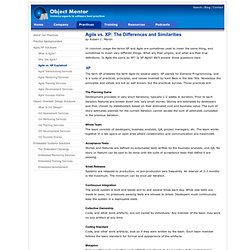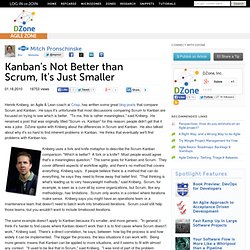

Why Agile or XP? (Object Mentor, 2006) Today, the mainstream software industry has a "poor track record" when it comes to delivering working software on time and within budget.

It is widely reported that 80% of all software projects fail, and last year, the IEEE conservatively estimated that over $60 billion dollars was spent on failed software projects. What a disaster! The Top 5 Reasons Projects Fail When asked why their projects failed, managers and employees cited a wide range of issues. But these 5 reasons surfaced over and over again, as the main reasons why their projects failed: Lack of end-user (customer) involvement Poor requirements Unrealistic schedules Lack of change management Lack of testing Inflexible and bloated processes Here's how Agile addresses these problems head on... So clearly, with so many project failing, there's Ota be a better way. The Customer Is King... To address the lack of end-user or customer involvement, Agile made the customer a member of the Agile Product Team. Agilely Timer (Pyxis Tech)
Agile Lessons Learned #12: Making Room For Passion (Pyxis blog, Nicholas Lemay, 17.09.2010) The autonomous individual, striving to realize himself and prove his worth, has created all that is great in literature, art, music, science and technology.

The autonomous individual, also, when he can neither realize himself nor justify his existence by his own efforts, is a breeding call of frustration -Eric Hoffer In Agile literature, a lot of focus in placed on team members needing to organize themselves. But what about the managers role in providing a proper Agile environment ?
In every management class I’ve ever followed, one of the chief concerns was that managers need to be leaders. Leadership is often summed up as being able to motivate other people into performing better than they normally would without your intervention. Things that push me towards greater accomplishments are when I can follow my passions and be passionate about what I’m doing. Are you lucky enough to be working in such en environment ? How many new things have you learned in the past year ? -Nicholas Lemay. Agile Requirements Breakdown Structure (David Bulkin, 31.01.2010) In agile when we talk about requirements, we often talk about epics, features and user stories.
But, do we really know how these different levels of requirements fit together, and how they relate to vision, goals and outcomes? This post provides a simple example of what a requirements breakdown can look like. This is nothing new and is similar to a functional breakdown structure, or product oriented work breakdown structure that has been used since I started my career over 25 years ago. An Example It Starts with a Vision At the top of the hierarchy is a vision. Be the eBanking Provider of choice for small business customers.
Agile vs XP: The Differences and Similarities (Object Mentor, Robert C. Martin, 2006) By Robert C.

Martin In common usage the terms XP and Agile are sometimes used to mean the same thing, and sometimes to mean very different things. What are their origins, and what are their true definitions. Is Agile the same as XP? Is XP Agile? The term XP predates the term Agile by several years. The Planning Game Development proceeds in very short iterations, typically 1-2 weeks in duration. Whole Team. Kanban's Not Better than Scrum, It's Just Smaller (Agile Zone, Michel Pronschinske, 10.05.2009) Henrik Kniberg, an Agile & Lean coach at Crisp, has written some great blog posts that compare Scrum and Kanban.

He says it's unfortunate that most discussions comparing Scrum to Kanban are focused on trying to see which is better. "To me, this is rather meaningless," said Kniberg. He renamed a post that was originally titled "Scrum vs. Kanban" for this reason; people didn't get that it was a joke. DZone spoke with Kniberg about the differences in Scrum and Kanban. Kniberg uses a fork and knife metaphor to describe the Scrum-Kanban comparison: "Which is better? The same example doesn't apply to Kanban because it's smaller, and more generic. He says ideas like visualization of work and limiting work in progress are intuitive ideas that are hard to find fault with. If used correctly, Kanban, Scrum, and other methods can work together effectively. If you want to learn more how Scrum and Kanban relate take a look at Henrik's new book "Kanban and Scrum - making the most of both".
Agile Project Management for Agile Development. 12 principles for Agile Development (LiquidConcept, Julien Henzelin) Scrum: A Primer (Agile Atlas)